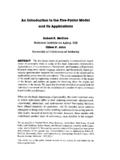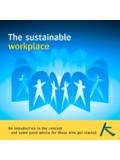Transcription of Workplace bullying: Escalated incivility
1 Workplace bullying : Escalated incivilityBy Gary NamieReprint # 9B03TF09 IVEY MANAGEMENT SERVICES November/December 2003 COPYRIGHT 2003To order copies or request permission to reproduce materials,pleasecontact:Ivey Publishing,Ivey Management Servicesc/o Richard Ivey School of BusinessThe University of Western OntarioLondon,Ontario N6A 3K7 Tel: (519)661-3208 Fax: (519)661-3882 Email: Management Services prohibits any form of reproduction,storage ortransmittal of thismaterial without its written material is not coveredunder authorization formCanCopy or any other reproduction rights Business Journal Onlineis published by Ivey Management Servicesa division ofthe Richard Ivey School of subscription information,please contact:Tel: (519) 661- 4215 Email.
2 M P R O V I N G T H E P R A C T I C E O F M A N A G E M E NT- 1 -Ivey Business Journal November/December 2003 The time has come to treat Workplace bullyingthe same as sexual harassment or racialdiscrimination, to identify the perpetrators,establish rules of conduct and penalties, and evenpass laws prohibiting and penalizing bullying . Thisauthor, an expert on the subject, draws acompelling picture of Workplace bullying andsuggests a blueprint that can help employersreduce or even eliminate Gary NamieGary Namie is co-founder of The WorkplaceBullying & Trauma Institute, an education,research and advocacy organization( ) and co-author of The BullyAt Work (Sourcebooks, 2003).
3 He is a socialpsychologist and consultant, and former professorof management at the University of SouthernCalifornia."Violence in the Workplace begins long beforefists fly or lethal weapons extinguish resentment and aggression routinelydisplace cooperation and communication,violence has occurred."Bernice Fields, ArbitratorThe bullying phenomenonBullying in the Workplace is far too widespread today,but before we can come to understand it, we mustunderstand that bullying is different from harmlessincivility, rudeness, boorishness, teasing and other well-known forms of interpersonal torment. bullying is aform of violence, but only rarely involves fighting,battery or homicide.
4 It is mostly sub-lethal, non-physicalviolence. And as our research data show, bullyingcrosses boundaries of gender, race and bullying : Escalated incivilityConsider that Workplace incivility , bullying andphysical violence lie on a 10-point continuum oforganizational disruption. Incivilities range from 1 to3, while bullying covers mild to severe interference withthe accomplishment of legitimate business interests,reflecting scores of 4 to 9. The highest score is reservedfor battery and homicide which grind work completelyto a halt. A parallel dimension views the consequencesfrom the perspective of the mistreated cause little to no harm, bullying can causemild to severe harm, and physical violence can result short history of Workplace bullyingThe founder of the international anti-bullyingmovement, Heinz Leymann, cared most about bullying 'simpact on the health of individuals.
5 Leymann was aGerman psychiatrist who established the world's firstWork Trauma clinic in Sweden in the 1980's. Hedocumented the traumatization that can result fromsustained "psychological terrorization" in the workplaceHe used the term "mobbing." The term "workplacebullying" was coined by the pioneering British journalistAndrea Adams in 1992, who applied bullying toadulthood Ruth Namie and I introduced the term "workplacebullying" to the in the popular press in 1998. Ourassociate, David Yamada, professor of law at SuffolkUniversity in Boston, wrote the seminal article for thelegal community in March, 2000 (Georgetown LawJournal, 2000, , issue 3, "The Phenomenon ofWorkplace bullying and the Need for Status-BlindHostile Work Environment Protection," Pp.)
6 475-536.)We define Workplace bullying as "status-blind"interpersonal hostility that is deliberate, repeated andsufficiently severe as to harm the targeted person's healthor economic status. Further, it is driven by perpetrators'- 2 -Ivey Business Journal November/December 2003need to control another individual, often undermininglegitimate business interests in the best estimate of bullying 's prevalence in the from a year 2000 survey that randomly sampledMichigan residents. The researchers found that of respondents reported a severe disruption oftheir lives from Workplace aggression. Thus, we canextrapolate and say that about one in six workers isbullied. (Loraleigh Keashly and Karen Jagatic, WayneState University, 2000.
7 Characteristics of bullyingHow can a problem so prevalent not trigger societaloutrage? Silence by targeted persons is understandablebecause shame stems from being controlled andhumiliated. Co-workers' silence makes sense in a fear-plagued environment when people are unsure if theymight next be puzzling is the typical employer response in lightof internal anti-harassment and anti-violence a survey conducted by the Workplace bullying &Trauma Institute, respondents described the nature ofsupport, or lack of it, provided by others at work. Targetswho had reported the abusive misconduct to theperpetrator's (bully's) manager and had asked for relief,elicited positive, helpful responses in only 18 percentof cases.
8 In 42 percent of instances the bully's bossactually compounded the problem. And in 40 percentof cases, the boss did nothing, which is not a neutralresponse after help was explicitly requested. HumanResources and anti-discrimination officers weresimilarly unhelpful: 17 percent took positive steps tostop the bullying , 32 percent reacted negatively, and 51percent did encompasses mistreatment that includessame-sex and same-race harassment. Our researchdiscovered that in only 25 percent of bullying cases doesthe target have protected group status and thus qualifythe offenses as sexual harassment or racialdiscrimination. A university survey conducted byUniversity of Illinois researchers found a similardominance of bullying over forms of illegal fact that bullying is not illegal makes it easy toignore even though it is three times more prevalent thanits better-recognized, illegal and men are bullies.
9 Women comprise 58percent of the perpetrator pool, while men represent 42percent. Our research also shows that when the targetedperson is a woman, she is bullied by a woman in 63percent of cases; when the target is male, he is bulliedby a man in 62 percent of incidents. Most bullying issame-sex harassment which is ignored by laws andemployer policies. Overall, women comprise themajority of bullied people (80 percent).In fact, WBTI research shows that half of all bullyingis woman-on-woman. Unless the target enjoys protectedstatus based on race, ethnicity, religion or disability, itis not likely that the current laws will provide the targetwith legal redress. Without laws, employers are reluctantto recognize, let alone correct or prevent, destructivebehavior, preferring to minimize it as "personalityclashes.
10 " bullying is nearly invisible. It is non-physical, andnearly always sub-lethal Workplace violence. Workplacehomicide grabs headlines as vivid rare events even inthe violent United States. Corporate decision makersinvest heavily in prevention and response processes,complete with zero tolerance contrast, bullying is psychological violence, mostlycovert and sometimes overt. It is psychological violence,both in its nature and impact. Regardless of howbullying is manifested -- either verbal assaults orstrategic moves to render the target unproductive andunsuccessful -- it is the aggressor's desire to control thetarget that motivates the action. The major risk ispsychological damage, but counseling is not offered byemployers to complainants who report of how bullying ismanifested -- either verbalassaults or strategic moves torender the target unproductiveand unsuccessful -- it is theaggressor's desire to control thetarget that motivates the action- 3 -Ivey Business Journal November/December 2003A recent study by the United States Postal Serviceprovided comparative frequencies: physical assaults, 1in 25; illegal harassment 1 in 8; and verbal abuse 1 in are not interested in the most commonnegative trend in contemporary workplaces, abusiveinterpersonal relationships.








